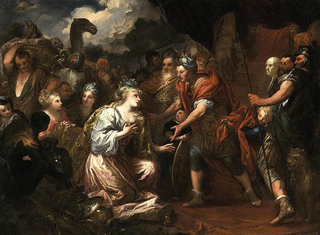
Andrea Mantegna was an Italian painter, a student of Roman archeology, and son-in-law of Jacopo Bellini.

Frans Pourbus the Younger (1569–1622) was a Flemish painter, son of Frans Pourbus the Elder and grandson of Pieter Pourbus. He was born in Antwerp and died in Paris. He is also referred to as "Frans II".

Pisanello, born Antonio di Puccio Pisano or Antonio di Puccio da Cereto, also erroneously called Vittore Pisano by Giorgio Vasari, was one of the most distinguished painters of the early Italian Renaissance and Quattrocento. He was acclaimed by poets such as Guarino da Verona and praised by humanists of his time, who compared him to such illustrious names as Cimabue, Phidias and Praxiteles.

Lorenzo Costa was an Italian painter of the Renaissance.

Justus Sustermans, Joost Sustermans or Suttermans, his given name Italianised to Giusto, was a Flemish painter and draughtsman who is mainly known for his portraits. He also painted history and genre paintings, still lifes and animals.

Giuseppe Bazzani was an Italian painter of the Rococo.

Giacinto Gimignani was an Italian painter, active mainly in Rome, during the Baroque period. He was also an engraver in aquaforte.

Lorenzo Garbieri was an Italian painter of the early-Baroque period, active mainly in Bologna. He was one of the painters in the studio of Ludovico Carracci and is sometimes called il nipote dei Carracci. He was said to be one of the most successful imitators of Ludovico, to whose style he added the character of Caravaggio.

Fermo Guisoni was an Italian painter of the Renaissance period, active mainly in his native city of Mantua.

Pietro Dandini was an Italian painter of the Baroque period, active mainly in Florence.

Girolamo Donnini was an Italian painter of the Baroque period, born in the town of Correggio, Emilia-Romagna. He was a pupil of the painters Francesco Stringa in Modena, and then of Giovanni Gioseffo dal Sole in Bologna, then traveled to Forlì to work with Carlo Cignani.

Alessandro Bardelli (1583–1633) was an Italian painter of the Baroque period.

Francesco Maria Raineri was an Italian painter of the late-Baroque, mainly active in Mantua.

Bicci di Lorenzo (1373–1452) was an Italian painter and sculptor, active in Florence.

Bonaventura Berlinghieri was an Italian painter from Lucca, Italy, of the Gothic period. He was son of painter Berlinghiero Berlinghieri and brother of Barone and Marco Berlinghieri.

Jacob Denys or Jacob Denys (II) (1644–1708) was a Flemish Baroque painter. His known works are mainly portraits. He also painted landscapes and history paintings. After training in Antwerp, he worked for a long time in Italy where he enjoyed the patronage of Duke of Mantua, Ferdinando Gonzaga, and the Duke of Tuscany, Cosimo III de' Medici.

Frans Geffels, known in Italy as Francesco Geffels, was a Flemish painter, printmaker, architect, stage designer and designer of ephemeral structures for solemn and festive occasions. After training in his native Antwerp, he was mainly active in Mantua, where he was prefetto delle fabbriche to the Duke, a role that gave him the direction of the artistic and construction activities undertaken by the Ducal court. He worked also on projects for the local aristocratic class of Mantua. In addition, he completed projects for the Liechtenstein princes and for the imperial court in Vienna.
Benedetto Orsi was an Italian painter of the Baroque period.

Mariano Graziadei also known as Mariano da Pescia, was an Italian painter of the early-Renaissance period, active in Florence. He was born in Pescia, and trained under Ridolfo Ghirlandaio. He painted a Holy Family for the chapel of the Signoria in the Palazzo Vecchio of Florence.

The Mantegna funerary chapel is one of the chapels of the Basilica of Sant'Andrea, Mantua. It houses the tomb of the painter Mantegna and his last two paintings – Baptism of Christ and Holy Family with St John the Baptist, St Elizabeth and St Zacharias (1504–1506). Its frescoes from 1507 were painted by his sons Ludovico and Francesco and by a young Correggio. The tomb bears a bronze figure of Mantegna by Gianmarco Cavalli.


















